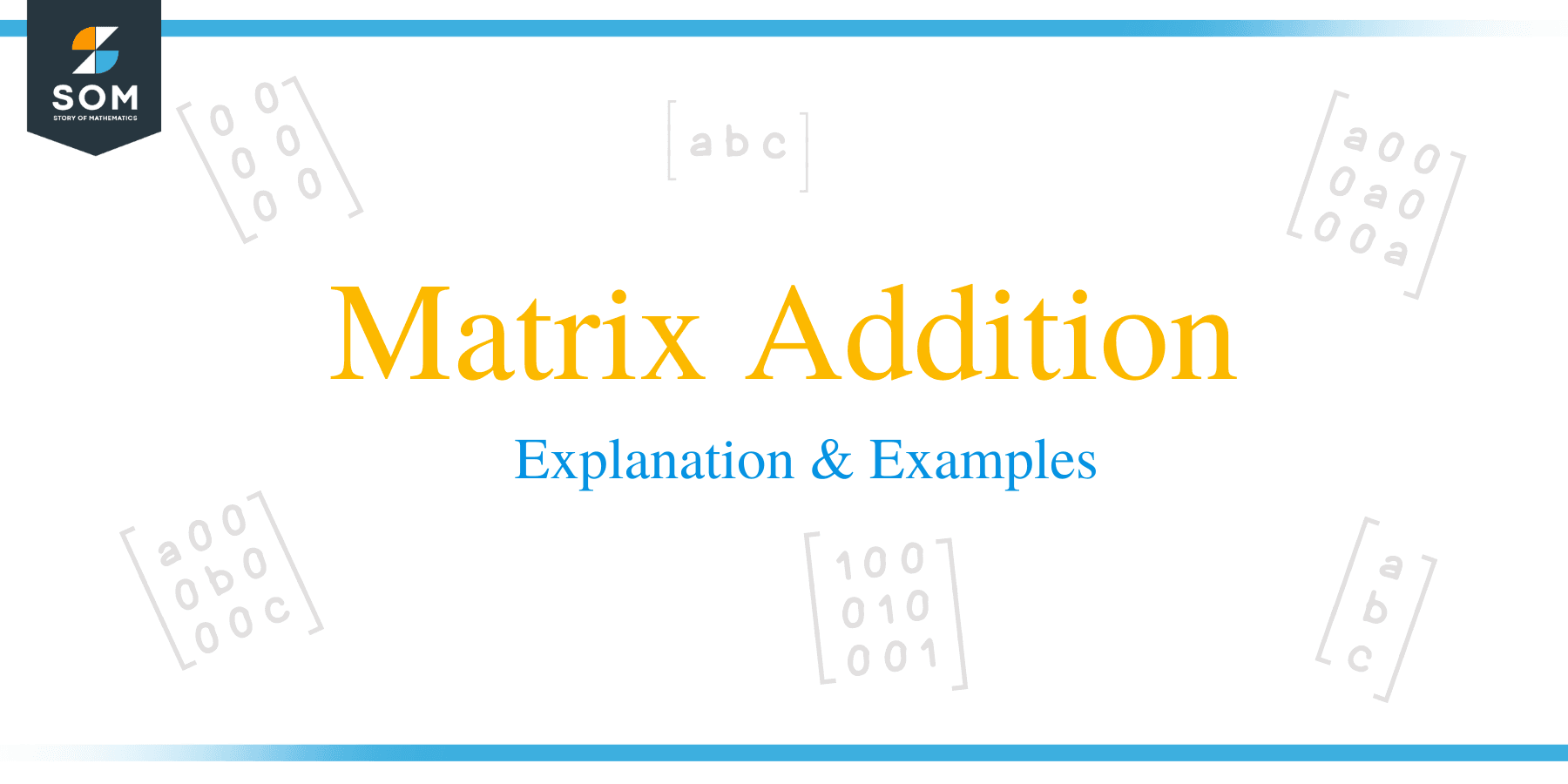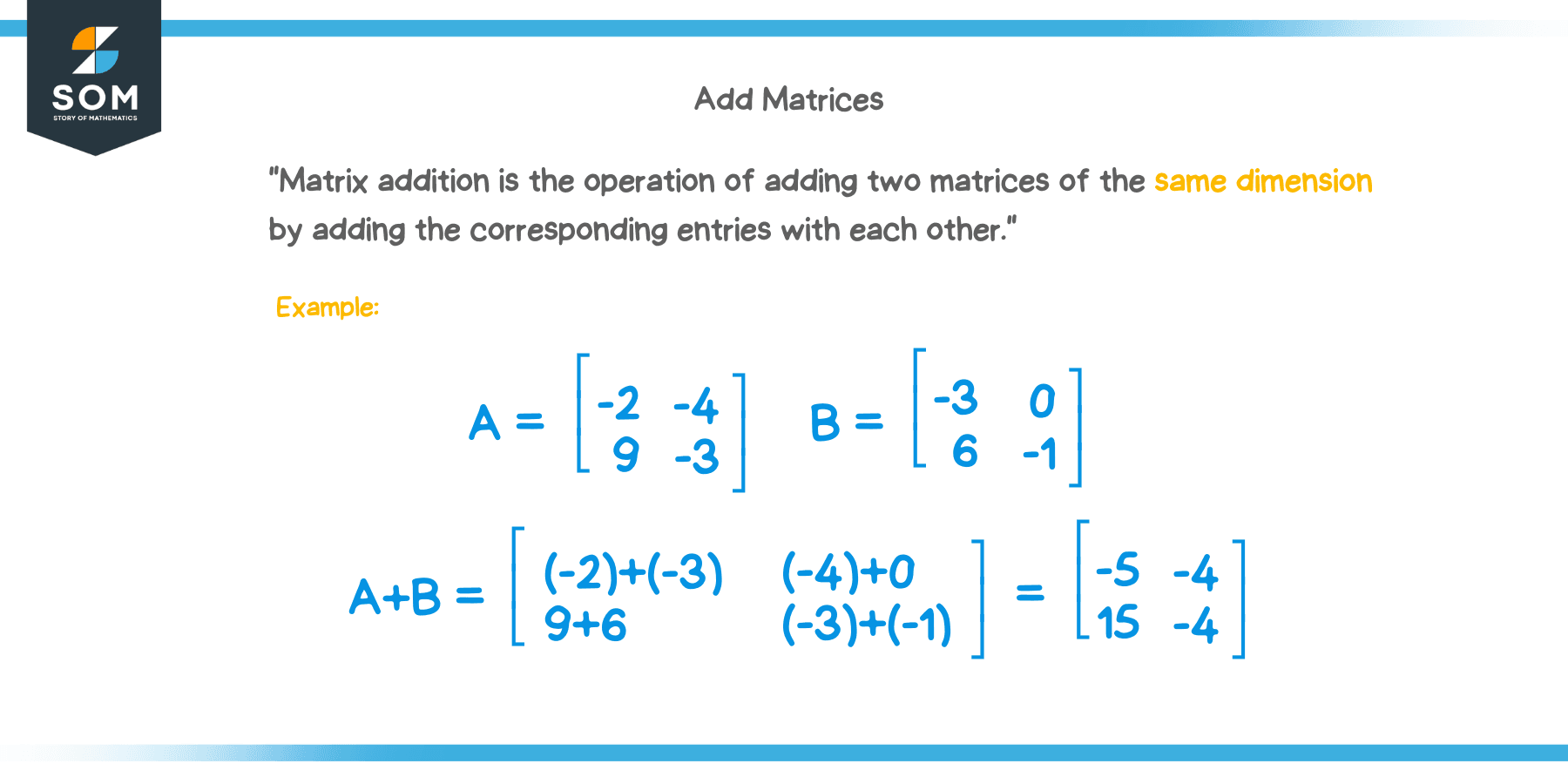- Home
- >
- Matrix addition – Explanation & Examples
Matrix Addition – Explanation & Examples
 The $ 4 $ operations we can do on matrices are addition, subtraction, scalar multiplication, and matrix multiplication. Matrix Addition is one of them.
The $ 4 $ operations we can do on matrices are addition, subtraction, scalar multiplication, and matrix multiplication. Matrix Addition is one of them.
Note: Matrix division isn’t a defined operation. We can divide a matrix by only a scalar number.
So, how can we define matrix addition? Let’s take a look at the definition below:
Matrix addition is the operation of adding two matrices of the same dimension by adding the corresponding entries with each other.
This article will show the conditions that make matrix addition possible, how you can add matrices, and a few examples showing matrix addition.
When can you add matrices?
Just like with numbers, can we add any matrices?
The answer is NO!
We can only add $ 2 $ matrices when they have the same dimension. That is, if $ 2 $ matrices have the same number of rows and columns, then, and only then, we can add the $ 2 $ matrices together.
Recall that the dimension of a matrix is its number of rows and number of columns. If there are $ m $ rows and $ n $ columns of a matrix, we can say that the matrix has dimensions $ m \times n $. To know more about the dimensions of a matrix, check this article out!
Remember, the resulting matrix from the operation of matrix addition will be of the same dimension as the matrices that produced it.
How to add matrices?
After concluding that matrices have the same dimensions, add $ 2 $ matrices by adding the corresponding elements. Consider Matrix $ A $ and Matrix $ B $ shown below:
$ A = \begin{bmatrix} { – 2 } & { – 4 } \\ 9 & { – 3 } \end {bmatrix} $
$ B = \begin{bmatrix} { – 3 } & 0 \\ 6 & { – 1 } \end {bmatrix} $
Both Matrix $ A $ and $ B $ have $ 2 $ rows and $ 2 $ columns. Hence, the dimensions of the matrices are $ 2 \times 2 $. Since they are equal, we can add the $ 2 $ matrices by adding each corresponding entry to each other. The process is shown below:
$ A + B = \begin{bmatrix} { – 2 + – 3 } & { – 4 + 0 } \\ { 9 + 6 } & { – 3 + – 1 } \end {bmatrix} $
$ A + B = \begin{bmatrix} { – 5 } & { – 4 } \\ { 15 } & { – 4 } \end {bmatrix} $
Now, let’s consider the two matrices shown below:
$ A = \begin{bmatrix} { 0 } & { – 5 } \\ 1 & 4 \end {bmatrix} $
$ B = \begin{bmatrix} { – 5 } & 0 \\ 6 & 0 \\ 3 & 7 \end {bmatrix} $
Is $ A + B $ defined?
No! Matrix $ A $ has dimensions $ 2 \times 2 $. Matrix $ B $ has dimensions $ 3 \times 2 $. Since the dimensions of both the matrices aren’t equal, matrix addition isn’t defined! We can’t add Matrix $ A $ and $ B $ because there won’t be corresponding entry for each element of Matrix $ A $ and Matrix $ B $.
Rules of Matrix Addition
We can write $ 4 $ rules for matrix addition.
- You can only add matrices with the same dimensions (that means the number of rows and columns of the first matrix must equal the number of rows and columns of the second matrix.)
- The resultant matrix from matrix addition will have the same dimension as the original matrices that produced it.
- Matrix addition is commutative (i.e. $ A + B = B + A $). You can change the order of matrices when adding $ 2 $ matrices together.
- Matrix addition is associative (i.e. $ ( A + B ) + C = A + ( B + C ) $). When adding $ 3 $ matrices, you can add any $ 2 $ matrices first, then add the third matrix with the result of the addition of the first two.
Let’s look at some examples of Matrix Addition.
Example 1
Check whether matrix addition between Matrix $ A $ and Matrix $ B $ is defined. If so, add them.
$ A = \begin{bmatrix} { 3 } & { – 3 } \\ 0 & 3 \end {bmatrix} $
$ B = \begin{bmatrix} { 6 } & { 4 } \\ { – 2 } & 1 \end {bmatrix} $
Solution
For matrix addition to be defined, the dimension of each matrix must be equal. Matrix $ A $ is a $ 2 \times 2 $ matrix. Matrix $ B $ is also a $ 2 \times 2 $ matrix. Thus, matrix addition between Matrix $ A $ and $ B $ is defined.
Now, let’s add the $ 2 $ matrices together by adding each corresponding entries to each other. Shown below:
$ A + B = \begin{bmatrix} { 3 + 6 } & { – 3 + 4 } \\ { 0 + – 2 } & { 3 + 1 } \end {bmatrix} $
$ A + B = \begin{bmatrix} { 9 } & { 1 } \\ { – 2 } & { 4 } \end{bmatrix} $
Example 2
For the $ 2 $ matrices shown below, find $ C + D $.
$ C = \begin{bmatrix} { 1 } & { – 8 } \\ 0 & 3 \\ 0 & { – 4 } \end {bmatrix} $
$ D = \begin{bmatrix} { 5 } & { – 8 } & { – 1 } \\ 0 & 6 & 0 \end {bmatrix} $
Solution
The dimension of Matrix $ C $ is $ 3 \times 2 $. The dimension of Matrix $ D $ is $ 2 \times 3 $. Even though the dimensions are equivalent, we can’t add Matrix $ C $ with Matrix $ D $. The order of dimensions are also important. A $ 3 \times 2 $ matrix is not equal to a $ 2 \times 3 $ matrix. Thus, we cannot add Matrix $ C $ and Matrix $ D $.
We can solve basic algebraic equations with matrix addition. Consider the example shown below.
Example 3
Find the values of $ a $ and $ b $ given the following equation:
$ \begin{pmatrix} { 5 } & { 2 } \\ b & { – 2 } \end {pmatrix} + \begin{pmatrix} { a } & { 2 } \\ 1 & { – 2 } \end {pmatrix} = \begin{pmatrix} { – 15 } & { 4 } \\ { – 2 } & { – 4 } \end {pmatrix} $
Solution
We can add corresponding entries to solve for $ a $ and $ b $. First, let’s add up the corresponding elements for $ a $ and solve for the variable:
$ 5 + a = – 15 $
$ a = – 15 – 5 $
$ a = – 20 $
Now, let’s find the value of $ b $ by adding the corresponding entries for $ b $:
$ b + 1 = – 2 $
$ b = – 2 – 1 $
$ b = – 3 $
It’s your turn. Try these practice questions.
Practice Questions
- Consider the following $ 3 $ matrices:
$ P = \begin{pmatrix} { – 1 } & { 3 } \\ 6 & { 0 } \end {pmatrix} $
$ Q = \begin{pmatrix} { 5 } & { -1 } \\ { – 2 } & 1 \end {pmatrix} $
$ R = \begin{pmatrix} 3 & 1 \\ 1 & 3 \\ -1 & -3 \end {pmatrix} $
Find:- $ P + Q $
- $ Q + R $
- $ Q – Q $
- Find the values of $ a $, $ b $, and $ c $ given the following equation:
$ \begin{pmatrix} { 3 } & { 2 } & 0 \\ b & { – 2 } & 3 \\ 11 & a & -2 \end {pmatrix} + \begin{pmatrix} { 3 } & { 2 } & c \\ 5 & { – 2 } & 3 \\ 11 & -1 & -2 \end {pmatrix} = \begin{pmatrix} { 6 } & { 4 } & -9 \\ 20 & { – 4 } & 6 \\ 22 & -3 & -4 \end {pmatrix} $
Answers
- The first two problems are addition. We will follow the matrix addition rules. The third problem is subtraction. But remember, subtraction is just another form of addition. The answers are shown below.
- Both Matrices $ P $ and $ Q $ are $ 2 \times 2 $ matrices. Thus, we add the $ 2 $ matrices by adding the corresponding entries. Shown below:
$ P + Q = \begin{pmatrix} { -1 +5 } & { 3+ – 1 } \\ {6 + – 2} & {0 + 1} \end {pmatrix} $
$ P + Q = \begin{pmatrix} { 4 } & { 2 } \\ 4 & 1 \end {pmatrix} $ - We can’t add Matrix $Q$ and Matrix $R$ because their dimensions aren’t the same. Matrix $Q$ is a $ 2 \times 2$ matrix and Matrix $R$ is a $3 \times 2$ matrix.
- Let’s negate (change the sign of every element) the second $Q$ matrix and add both.
$ Q + (-Q) = \begin{pmatrix} { 5 } & {- 1 } \\ {- 2} & {1} \end {pmatrix} + \begin{pmatrix} { -5 } & {1 } \\ {2} & {-1} \end {pmatrix} $
$ Q – Q = \begin{pmatrix} { 0 } & 0 \\ 0 & 0 \end {pmatrix} $The result is a $ 2 \times 2 $ matrix with all elements $ 0 $. This is known as a zero matrix or a null matrix.
- Both Matrices $ P $ and $ Q $ are $ 2 \times 2 $ matrices. Thus, we add the $ 2 $ matrices by adding the corresponding entries. Shown below:
- We can add corresponding entries to solve for $ a $, $ b $, and $ c $. First, let’s add up the corresponding elements for $ a $ and solve for the variable:
$ a + – 1 = -3 $
$ a = – 3 + 1 $
$ a = – 2 $Now, let’s find the value of $ b $ by adding the corresponding entries for $ b $:
$ b + 5 = 20 $
$ b = 20 – 5 $
$ b = 15 $Lastly, let’s find the value of $ c $ by adding the corresponding entries for $ c $:
$ 0 + c = -9 $
$ c = -9 $
